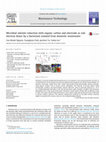Papers by Khanh Nguyen Van

Strain THL1 can use organic or electrode as electron donor for Se(IV) reduction. Strain THL1 can ... more Strain THL1 can use organic or electrode as electron donor for Se(IV) reduction. Strain THL1 can remove 1 mM of Se (IV) within 3 d under heterotrophic condition. The Se(IV) reduction rate by electrotrophy was lower than that by heterotrophy. Strain THL1 was found to be affiliated with Cronobacter spp. g r a p h i c a l a b s t r a c t a b s t r a c t Selenium is said to be multifaceted element because it is essential at a low concentration but very toxic at an elevated level. For the purpose of screening a potential microorganism for selenite bioremediation, we isolated a bacterium, named strain THL1, which could perform both heterotrophic selenite reduction, using organic carbons such as acetate, lactate, propionate, and butyrate as electron donors under microaerobic condition, and electrotrophic selenite reduction, using an electrode polarized at À0.3 V (vs. standard hydrogen electrode) as the sole electron donor under anaerobic condition. This bacterium determined to be a new strain of the genus Cronobacter, could remove selenite with an efficiency of up to 100%. This study is the first demonstration on a pure culture could take up electrons from an electrode to perform selenite reduction. The selenium nanoparticles produced by microbial selenite reduction might be considered for recovery and use in the nanotechnology industry.








Uploads
Papers by Khanh Nguyen Van